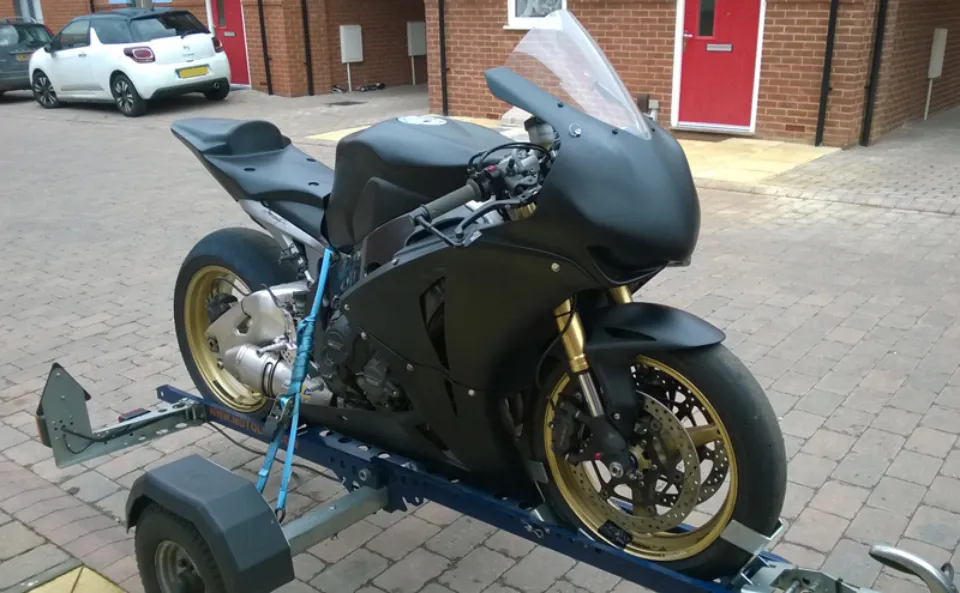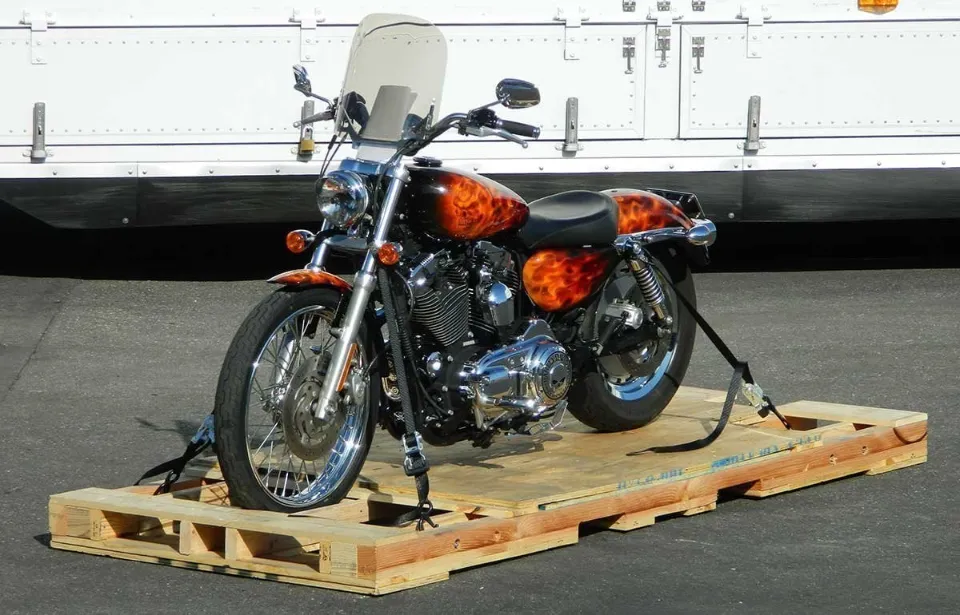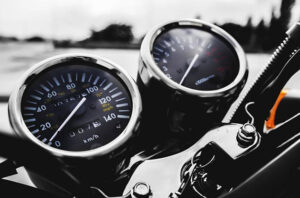Here’s some handy advice on how to load and tie down a motorcycle!
No matter whether we’re traveling to a rally in another time zone or taking a stroll through the nearby hills in the pouring rain if the choice is between transporting a motorcycle or riding it, we’ll always choose the latter. Our options are limited at times.
Secure the ramp to your car and make sure it is stable all three times. Using a ratchet strap is a reliable method for securing the ramp. Just tie one end to the rear bar or diff of your car and loop the other end around the ramp. There will be no movement of that ramp!
You should be able to securely secure your bike for transport by the end of this guide.
Steps to Tie Down Your Motorcycle
- Gather the necessary equipment
- Load motorcycle onto trailer or truck
- Rest motorcycle on kickstand or wheel chock
- Pass soft loop straps securely around handlebars
- Attach tie-down hooks to soft loops
- Attach an opposite tie-down hooks to anchor points
- Tighten the straps until all the slack is gone
I’ll go into more detail about each of these seven steps in the sections that follow, as well as offer you some advice and supplies you’ll need to get the job done.
Step 1. Gather the Necessary Equipment

Before packing your motorcycle, you’ll need a few things. You will primarily require ratchet tie-down straps, soft loop straps, anchor points, and perhaps a wheel chock. These things are essential for making sure your motorcycle is as safe and secure as possible, some of which you may already have and some of which you may not.
Step 2. Load Motorcycle onto Trailer Or Truck
This process’s most challenging step may be figuring out how to load your motorcycle onto your truck or trailer. If you’re Superman or Dwayne Johnson, you might be able to load your motorcycle yourself, but if you don’t already have loading ramps, you might want to consider getting some.
Loading ramps will ease the burden on your knees and back and make it almost too simple to load the bike onto your trailer or truck. A single ramp option is available for you since you will only need one ramp for a typical motorcycle.
Step 3. Rest Motorcycle on Kickstand Or Wheel Chock
You should stabilize your motorcycle as you begin to fasten the straps after loading it into your truck or trailer. Lower the kickstand if the motorcycle has one to keep it balanced while you secure the straps.
However, you need to make sure you put the kickstand up before you start traveling, so as to not damage it or the bike. The wheel chock is useful in this situation if your bike lacks a kickstand or if you’d like a little more stability. To help stabilize the motorcycle, you can simply bolt a wheel chock to your trailer or pickup truck; if you frequently transport your motorcycle, this is a great option.
Step 4. Pass Soft Loop Straps Securely Around Handlebars
It’s time to use those soft loop straps since you already know how useful they are. The most secure area of each handlebar will receive the soft loops. However, if at all possible, avoid attaching the straps directly to the handlebars as this could put additional strain on them and possibly damage them. Instead, if your bike has a triple tree, we advise attaching the straps there because it is much safer for the bike.
Additionally, you can save time and money by using ratchet straps with built-in soft loops. The premium ShockStrap tie-downs feature soft loops and integrated shock absorbers that will soften any blows and maintain constant tension on your bike even if it shifts slightly during travel.
Step 5. Attach Tie-down Hooks to Soft Loops
You will tie the tie-down hooks to the soft loops once you have the soft loops fastened around the handlebars or triple tree. Simply make sure that the tie-down hooks are fully hooked around the soft loops and that they won’t slide around the handlebars for this relatively easy step.
Step 6. Attach Opposite Tie Down Hooks to Anchor Points

Once you’ve fastened one end of the ratchet strap to the soft loop, you’ll attach the other end of the strap’s tie-down hook to the anchor point that you’ve either just installed on your trailer or truck or have already installed. Making sure that whatever you are attaching your strap to is safe and simple for the hook to grasp is all that is required instead of a D-ring anchor point.
Additionally, don’t just stop at fastening the handlebars. Along with the straps on each handlebar, we strongly advise using at least one additional strap on the back of the bike. If you want a snug fit, you can fasten a rear tie over the seat. If you want better rear stabilization, you can fasten a tie through the rear wheel.
Step 7. Tighten the Straps until All the Slack is Gone
The final step is to tighten that sucker down after everything has been connected and put it in its proper location. To ensure that the bike is properly secured and does not experience more tension on one side than the other, make sure that you add tension to each side of the straps equally.
We advise going back and forth to each side while tightening, even though it might seem a little tedious, to make sure it’s evenly secured.
Also, make sure you check everything one last time before you leave because even if you believe you are finished and ready to go, you might have overlooked something. To prevent them from coming undone while you’re traveling, make sure all the ratchets are closed and all the extra straps are tied up.
Tips to Consider While Secure a Motorcycle on a Trailer

- Have a partner help you: It is possible to complete the task faster as well as safer. You two can secure the bike much more quickly and easily if you are confident in what you are doing.
- Plan for the elements: You might need to cover your bike up against the weather depending on where you’re going. It would be very beneficial to have a tarp on hand and a way to fasten it over the bike.
- Know your truck or trailer bed: You should be aware of whether your truck bed or trailer can accommodate the transport of another vehicle. Your truck can be fitted with tracks and d-rings, but if the load is too great, your suspension may suffer damage.
- Do not cut corners: Instead of using substitutes, use the proper tools for the job. For instance, the rope is not a suitable replacement for ratchet straps. Because it is challenging to tighten the rope sufficiently to stop the bike from moving while being transported, it has a lower breaking strength than most ratchet straps.
When Transporting Your Motorcycle, Don’t
- Use the rear bag guards as attachment points; they will be yanked off.
- Long handlebars’ ends should be tied down. A few handlebars are rubber mounted and can compress, causing tie-down slippage. While some dealers are fine with this, we don’t think it’s acceptable.
- Pick the least expensive straps. The money you saved by purchasing budget straps won’t even come close to covering the cost of fixing your bike.
Conclusion: Safely Tie Down a Motorcycle
The rear should also be secured after the front has been finished. Repetition of the two-sided procedure at the back is not necessary, but it is crucial to sufficiently secure the rear end to prevent it from bouncing around in the event of hard braking or uneven terrain.
And if you plan to wait to unload the bike once you arrive at your destination, loosen the straps a little to relieve pressure on the fork seals.
Motorcycles can be secured in numerous ways. Some have more steps than others, while others have fewer. The most crucial element in completing the task correctly, regardless of the steps required, is your equipment.



